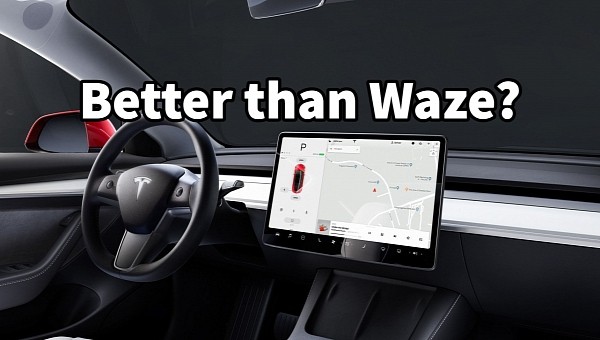Many consider Tesla a software company, and this is mostly true. Tesla EVs are not just transportation means but also data-collecting platforms offering unique features to owners. For instance, Tesla collects a lot of data about the roads and feeds them into its systems in real-time, helping other owners who might travel nearby.
We know how navigation software evolved from the times when map updates were never offered to the time of crowd-sourced data. It is possible today to know not only the shortest route between two points but also how busy the road is and what alternative routes would take you there faster. Waze improved on this tremendously, offering drivers the tools to report construction sites, potholes, and hazards along the routes, along with police position (country dependent) and even gas prices.
This is something that Tesla owners miss because the EV maker doesn't offer Apple CarPlay or Android Auto integration. Tesla owners are left with Tesla navigation, which is based on Google Maps. It's still a very capable mapping system, and white-hat hacker Green (@greentheonly) thinks it might be even better than Waze. It might not be obvious to the driver, but Tesla vehicles collect much information from the surrounding areas and feed it into the cloud. From there, it is processed and sent back to all cars that might need it.
Green has reverse-engineered how Tesla calculates alternate routes for its navigation system and discovered it's more complicated than just relaying Google Maps data. When online navigation is enabled, Tesla grabs the route from Google and feeds it into the Tesla maps service. This returns the best possible alternatives based on its own criteria. A lot is going on beneath the surface, as the Tesla maps service also queries useful information such as parking lots at the destination and any other interesting data it might be of help.
The system can correct map data in real time when changes happen in the road's configuration. Lane info, the direction of travel, and speed are also collected and analyzed, helping improve future recommendations for you and other Tesla drivers. This is why FSD Beta testers sometimes noticed that "the car took the same route but drove better this time." This is similar to how Waze works, but it is completely automated.
One interesting consequence of this revelation is that Tesla FSD/Autopilot works better when a route is set into the navigation system. This way, it fetches additional information about the path ahead, enabling all these optimizations. Another is that FSD is always better in regions with more beta testers because more information is available. This explains why FSD works better in California, especially in the Bay area.
Tesla's routing engine even goes the length to optimize the FSD experience. This means it is more likely to recommend a route where the FSD software already performed great for other drivers than another without such information. Whether that's good or bad, it's up to you to decide.
This is something that Tesla owners miss because the EV maker doesn't offer Apple CarPlay or Android Auto integration. Tesla owners are left with Tesla navigation, which is based on Google Maps. It's still a very capable mapping system, and white-hat hacker Green (@greentheonly) thinks it might be even better than Waze. It might not be obvious to the driver, but Tesla vehicles collect much information from the surrounding areas and feed it into the cloud. From there, it is processed and sent back to all cars that might need it.
Green has reverse-engineered how Tesla calculates alternate routes for its navigation system and discovered it's more complicated than just relaying Google Maps data. When online navigation is enabled, Tesla grabs the route from Google and feeds it into the Tesla maps service. This returns the best possible alternatives based on its own criteria. A lot is going on beneath the surface, as the Tesla maps service also queries useful information such as parking lots at the destination and any other interesting data it might be of help.
The system can correct map data in real time when changes happen in the road's configuration. Lane info, the direction of travel, and speed are also collected and analyzed, helping improve future recommendations for you and other Tesla drivers. This is why FSD Beta testers sometimes noticed that "the car took the same route but drove better this time." This is similar to how Waze works, but it is completely automated.
One interesting consequence of this revelation is that Tesla FSD/Autopilot works better when a route is set into the navigation system. This way, it fetches additional information about the path ahead, enabling all these optimizations. Another is that FSD is always better in regions with more beta testers because more information is available. This explains why FSD works better in California, especially in the Bay area.
Tesla's routing engine even goes the length to optimize the FSD experience. This means it is more likely to recommend a route where the FSD software already performed great for other drivers than another without such information. Whether that's good or bad, it's up to you to decide.
So I decided to look into how Tesla does alternate routes (I know, late) fully expecting to see they just get a few alternatives from Google and that's it and... nope, there's nothing like it!
— green (@greentheonly) March 30, 2023







